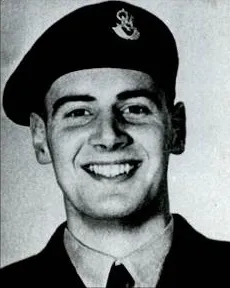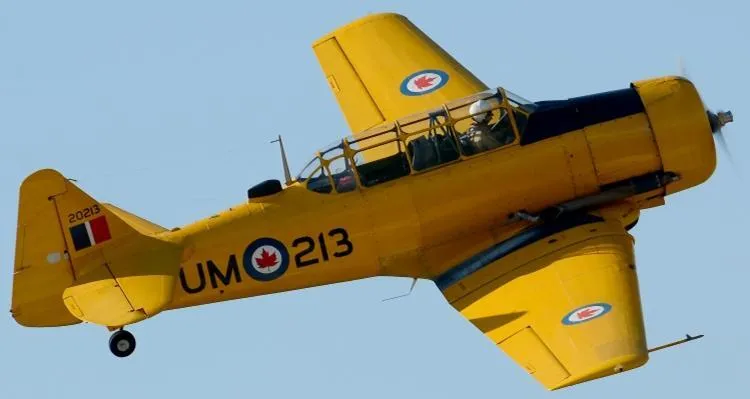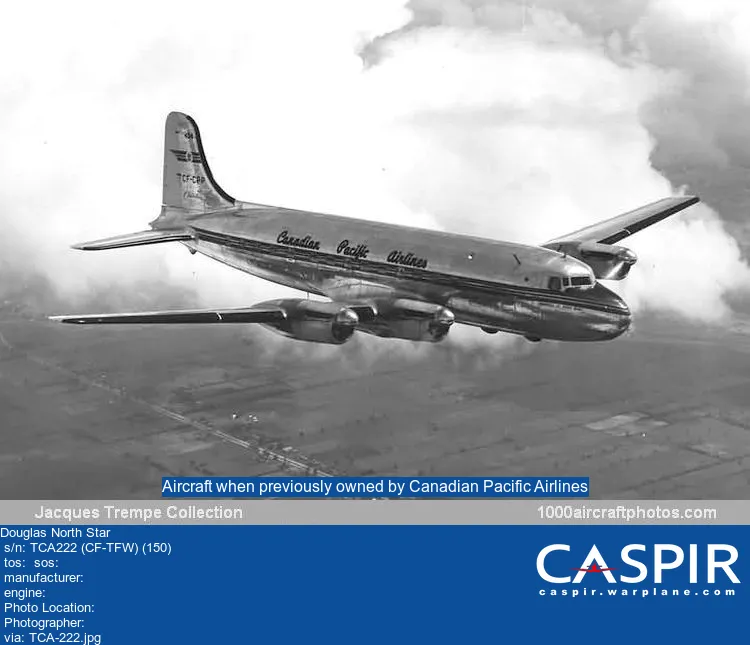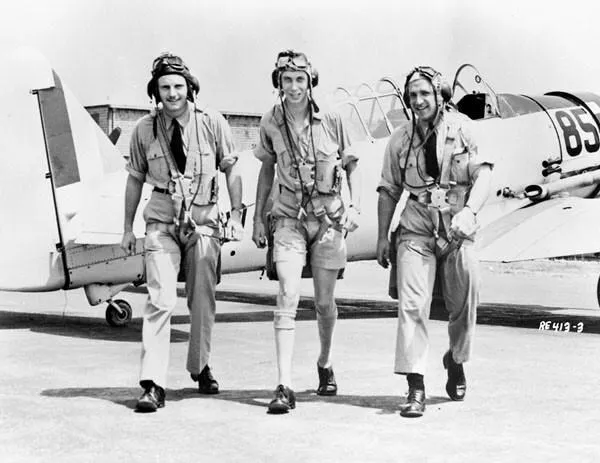Thorrat, Thomas Andrew (Pilot Officer (Acting))
Killed in Flying Accident 1954-April-08


Birth Date: 1932
Born: Kirkcaldy Scotland
Parents: son of John Marshall Thorratt and Jessie Bett Robertson
Spouse:
Home: Kirkcaldy Fife Scotland UK
Enlistment:
Enlistment Date: unkown date
Service
RAF
Unit
2 FTS- Flying Training School
Base
RCAF Moose Jaw
Rank
Pilot Officer (Acting)
Position
Pilot
Service Numbers
This incident involved multiple aircraft:
- North Star C4-1 Serial: TCA223
- Harvard Mk.IIB Serial: 3309
All the above aircraft in the above list are referenced in this report.
Accident Card - North American Harvard Mk.IIB serial:3309
This accident involved 2 aircraft on 1954-April-08. They are: Harvard s/n 3309, North Star s/n TCA223.
This accident involved 1 person. Thorrat
This accident had 37 fatalities. Marjorie Louise Quinney Civilian Killed service no: North Star TCA223, Agar Rodney Cawthra Adamson Civilian Killed service no: North Star TCA223, Mary Cynthia Adamson Civilian Killed service no: North Star TCA223, George William Sweny Civilian Killed service no: North Star TCA223, Alan Craig Civilian Killed service no: North Star TCA223, Henry Floyd "Harry" George Civilian Killed service no: North Star TCA223, Carol Nelson Civilian Killed service no: North Star TCA223, Ian Henry Bell Civilian Killed service no: North Star TCA223, Don Wilson Civilian Killed service no: North Star TCA223, Elbert Frederick Cameron Civilian Killed service no: North Star TCA223, Andrew Middlemass Smart Civilian Killed service no: North Star TCA223, Oscar Arthur Blanck Civilian Killed service no: North Star TCA223, George Herbert Gillett Civilian Killed service no: North Star TCA223, Dorothy Esther Nelson Civilian Killed service no: North Star TCA223, Abraham Belzberg Civilian Killed service no: North Star TCA223, William Thomas Reid Hunter Civilian Killed service no: North Star TCA223, Rupert Don Baugh Civilian Killed service no: North Star TCA223, Thomas Mayne "Pat" Reid Civilian Killed service no: North Star TCA223, Marjorie Reid Civilian Killed service no: North Star TCA223, Donald McKenzie Matheson Civilian Killed service no: North Star TCA223, Gerald Stanton Civilian Killed service no: North Star TCA223, James Crossen Civilian Killed service no: North Star TCA223, Alexander McVey Civilian Killed service no: North Star TCA223, William Irvin Brook Civilian Killed service no: North Star TCA223, Charles Gordon Hutton Civilian Killed service no: North Star TCA223, William Harry McLean Civilian Killed service no: North Star TCA223, George R Goodall Civilian Killed service no: North Star TCA223, John Goodall Civilian Killed service no: North Star TCA223, Mary Pirie Civilian Killed service no: North Star TCA223, Alice Ritchie Douglas Edwards Civilian Killed service no: North Star TCA223, June Myrtle Finney Civilian Killed service no: North Star TCA223, Martha Schultz Hadwen Civilian Collateral service no: North Star TCA223, Jeanne Sweny Civilian Killed service no: North Star TCA223, Douglas Warren Guthrie Civilian Killed service no: North Star TCA223, Louis Penner Civilian Killed service no: North Star TCA223, Caroline Nelson Civilian Killed service no: North Star TCA223,Pilot Officer (Acting) Thomas Andrew Thorrat RAF Killed in Flying Accident service no: Harvard 3309
Mission
Harvard Mk.IIB 3309
Operational 1954-April-08 to 1954-April-08
() () RCAF Moose Jaw
From Aviation Safety network:
The Canadair C-4 was on a flight to Vancouver and had been cleared on an IFR flight plan flying at 6000 feet on Green Airway 1 between Winnipeg and Calgary, which was the first intermediate stop. At 09:57 an RCAF Harvard Mk. II took off from RCAF Station Moose Jaw for a navigation cross-country exercise. The Harvard was climbing to 9000 feet, crossed the Airway at 6000 feet and collided with the C-4. A large portion of the wreckage fell on a house which was destroyed by fire, killing the only occupant. The Harvard pilot and all 35 occupants of the C-4 where also killed.
PROBABLE CAUSE: "1) Failure on the part of the pilots of both aircraft to maintain a proper lookout, the onus of responsibility for keeping out of the way being with the Harvard aircraft as it had the other on its own right side. 2) The Harvard aircraft in crossing the airway climbed through altitudes normally used by aircraft flying along the airway. 3) The Board up to the present has been unable to determine whether the window post on the left side of the Canadair C4-1 aircraft hid the Harvard aircraft from view, but there are indications that this was possible."
Harvard serial: 3309

Canadian Warplane Heritage Museum
The North American Harvard appeared in 1937, in response to a US Air Corps proposal for an advanced trainer. The first of 50 Harvard Mk. Is ordered by the Canadian Government were delivered to RCAF Sea Island, BC in July 1939. By early 1940, the Mk. II was being assembled in California with an all metal fuselage replacing the original tube and fabric structure. 1200 Mk. IIs were supplied from US sources, until Canadian built Harvards started being produced in 1941.
In August 1938, Noorduyn Aviation of Montreal farsightedly signed an agreement with North American, to build the Harvard under licence. When the British Commonwealth Air Training Plan (BCATP) came into being in December 1939, Noorduyn received its first orders and went on to produce nearly 2800 Harvard Mk. IIBs for the RCAF and the RAF, between 1940 and 1945. In Canada, Harvard Mk. IIBs were used as advanced trainers with the BCATP at fifteen Service Flying Training Schools across the nation. They helped pilots make to the transition from low powered primary trainers, like Fleet Finch or the de Havilland Tiger Moth, to high performance front line fighters such as the Spitfire.
At the end of WW II, although the RCAF retained the Harvard as a trainer, a large number of them were sold off to civilian operators. The RCAF soon regretted this, for by 1949 the Cold War with the Soviet Union was in full swing and the RCAF urgently needed trainers again. 100 T-6J Texans were leased temporarily from the USAF and a further 270 Harvards, the Mk. IV version, were ordered from Canadian Car & Foundry, Thunder Bay. The RCAF used the Harvard Mk. IV for a further fifteen years, before finally retiring it in 1966.
A total of 20,110 Harvards were built between 1938 and 1954, 3,370 of them in Canada. Countless numbers of privately owned Harvards are still flying today.
Canadian Warplane Heritage Museum's Harvard Mk. IV was built by Canadian Car & Foundry, Thunder Bay, Ontario in late 1951. The aircraft saw service at four RCAF flying schools across the nation until it was sold to a civilian owner in 1965. It was the third aircraft to join the Museum after Dennis Bradley, Alan Ness and John Weir donated it in 1973. Canadian Warplane Heritage Museum
Aircraft Images
North Star TCA223
North Star C4-1 TCA223
1954-April-08 Accident: Loc: Moose Jaw Names: Adamson | Adamson | Baugh | Bell | Belzberg | Blanck | Brook | Cameron | Craig | Crossen | Edwards | Finney | George | Gillett | Goodall | Goodall | Guthrie | Hadwen | Hunter | Hutton | Matheson | McLean | McVey | Nelson | Nelson | Nelson | Penner | Penner | Pirie | Quinney | Reid | Reid | Smart | Stanton | Sweny | Sweny | Wilson

Harvard 3309
Harvard Mk.IIB 3309
Used by No. 14 Service Flying Training School at RCAF Station Aylmer, Ontario. Used post war by No. 402 Squadron (Auxiliary) at Stevenson Field, Manitoba; and at RCAF Station Gimli, Manitoba. Category A damage on 8 April 1954. Mid air collision with Trans Canada Airlines North Star CF-TFW, near Moose Jaw.1942-03-09 Taken on Strength 2019-08-20
1942-September-29 Accident: 14 Service Flying Training School Loc: Aerodrome Names: Lipsit | Mcdonnell
1943-October-21 Accident: 14 Service Flying Training School Loc: Aerodrome Names: Scott
1944-February-28 Accident: 14 Service Flying Training School Loc: R1 Yarmouth Names: Mckitrick | Reekie
1954-April-08 Accident: Loc: Moose Jaw Names: Thorrat
1954-05-18 Struck off Strength Struck off after crash, see comments. 2019-08-20
Unit Desciption
2 FTS (2 Flight Training School)
RCAF.info - RCAF Station Moose Jaw SK
![]() YouTube - Abandoned Saskatchewan
YouTube - Abandoned Saskatchewan
